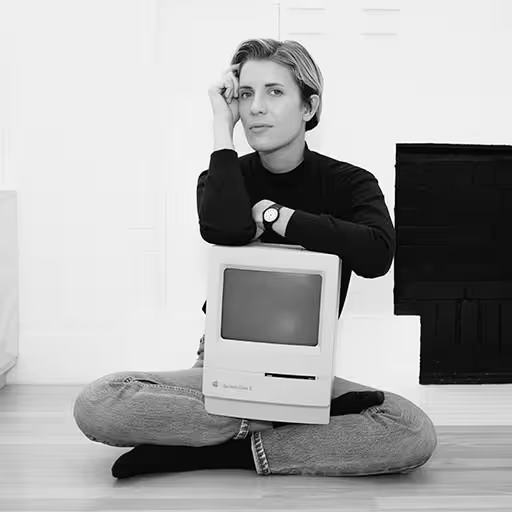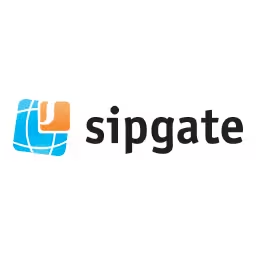Claire L. Evans

Claire L. Evans is a writer and artist working in Los Angeles. Her day job is as the singer and coauthor of the conceptual pop group YACHT. A science journalist and science-fiction critic, she is the founding editor of Terraform, VICE's science-fiction vertical, and has contributed to Motherboard, VICE, Frieze, The Guardian, WIRED, and Aeon. She regularly participates in panels, conferences, and screenings on the subject of technology and culture, including Moogfest, Eyeo Festival, Versions, WIRED x Design, the UCLA Center for the Art of Performance, the Kitchen, the Rubin Museum, the Hirshhorn Museum, TEDx, and the Center for Science and the Imagination. She is a member of the cyberfeminist collective Deep Lab, and her first book, Broad Band: The Untold Story of the Women who Made the Internet, will be published by Penguin Random House in Spring 2018.
Talk: Broad Band – What History’s Female Internet Pioneers can Teach us about Tomorrow
Claire Evans, author of Broad Band: The Untold History of the Women who Made the Internet, will share stories about the hardworking women who challenged convention to make key contributions to the history of our century’s most transformative cultural technology—the Internet. As we face issues of privacy, identity, and society in a networked world, we have much to learn from these women, who anticipated the Internet’s greatest problems, faced them, and discovered solutions we can still use today.
Transcription
[Digital Music]
Audience: [Applause]
Claire Evans: Yeah, this talk isn’t going to be about the sound of post-human music. I’m sorry. It’s going to be about feminism. Ooh!
Hi, that’s my test pattern. My name is Claire. I am a musician. I’m a writer. I’m an artist. I live in Los Angeles. This is me dressed like Steve Jobs because -- dress for the job you want -- that’s what they say.
Audience: [Laughter]
Claire: Back in March of this year, I published my first book. A big event in the life of a writer. It’s called Broad Band: The Untold Story of the Women Who Made the Internet, a very bold claim, the kind of claim that publishers love to make: women who made the Internet. And, you know, I took a more nuanced view, of course, but I wrote it because I wanted some new heroes. I wanted a few alternatives to the Steve Jobs of this world, as much as I love his personal style.
I wanted to understand what it means to be a woman engaging with, building, and using technology in this very weird, modern age that we live in. And, as it turns out, women and computing have a very long history. But, for the sake of convenience, I’m going to start relatively recently in 1892. [Laughter]
Audience: [Laughter]
Claire: Okay, so an act of collective imagination here. Can we all just sort of close our eyes and imagine that it is the year 1892? [Laughter] I’ll give you some contextual clues. Say you live in New York City, for example. In January of that year, an immigration processing center called Ellis Island has just opened for business and thousands of people are coming from Europe.
In March, in Massachusetts, the very first public game of “basketball” was played, invented by this man, Dr. James Naismith, who invented it because he was a sports instructor for children and he was trying to think of something to keep kids busy indoors during the winter. But, the winter is over, and it’s the first of May. Okay? So, just shy of summer, just shy of the 20th Century.
And, there’s this really strange ad in the New York Times, “A Computer Wanted.” Now, this is the very first instance of the word “computer” in print. And, no, it was not placed by a time traveler, by somebody stuck in the gilded age and jonesing for their MacBook. The person that placed this ad was not looking to purchase a computer. They were looking to hire one because, for close to 200 years, a computer was not a thing; it was a job, as in someone who computes, who performs computations for a living. The same for the word “calculator,” incidentally.
Say you wanted to answer that want ad. You’re looking for a job. In order to get the job, you would have to pass a mathematics test, of course. And, on your first day at work, you would probably sit down at a long table like one of these and work on crunching some complicated, large-scale math problem. You couldn’t do it alone because the math problem would be so large and so complex that you would be forced to work in a network of people all working in parallel and cross-referencing each other’s works so that there would be no mistakes.
With pen and paper alone and, of course, your mind, you would advance maritime navigation or ballistics or pure mathematics. You would make the underlying sort of computational infrastructure of the scientific age possible. You would make science possible.
Computing offices like this were thinking factories, so the 19th Century mathematician and scientist Charles Babbage, he called what computing offices did mental labor. And, that’s a good way to think about it because it was really just work that you did with your mind, in the same sense that hammering a nail is work that you do with your arm. It wasn’t seen as something that required intellectual talent or sophistication. It was just work.
But, human computers, well, they prepared ballistics trajectories during the war. They assisted in numerical studies of nuclear fission. They crunched astronomical data at Harvard. They cracked World War II codes at Bletchley Park. And, despite the diversity of the applications of their work, which was as diverse as the applications of any mathematics, the computers all had one thing in common. Can you guess what it was?
Audience: [Laughter]
Claire: Yes, they were all women. The human computers were all women, and computing was so much considered to be a woman’s job that, by the time mechanical computing came along, largely independently of their human counterparts, mathematicians would talk about computers and how long they took to process problems by talking about “girl years,” or they would describe units of machine labor as being equivalent to a “kilo girl.”
Audience: [Laughter]
Claire: [Laughter] So, women were the original measurement.
Audience: [Laughter]
Claire: So, from the beginning, women doing this kind of work were paid less than the men, the few men doing the same. When the astronomer Edward Charles Pickering wanted an arsenal of human computers for his Harvard lab, he hired only women, including his own maid, Williamina Fleming. He didn’t do this because he thought Williamina Fleming was a genius or because he had some kind of inherent respect for the female mind; he did it so he could hire twice as many people to do the same job.
But, the Harvard computers, well, they cataloged 10,000 stars. And, Williamina Fleming, she discovered the Horsehead Nebula and developed a common designation system for stars. Her colleague Annie Jump Cannon, probably the coolest name in scientific history--
Audience: [Laughter]
Claire: [Laughter] She could classify stellar spectrum data at a rate of three stars per minute, which I’m sure mechanical computers couldn’t catch up to for quite a long time. These women mapped the cosmos, but they were paid as much as unskilled workers, between $0.25 and $0.50 an hour, which was only slightly more than a factory worker at that time.
The historian David Alan Grier writes that women like this, they were not the talented daughters of loving fathers or the intelligent friends of sympathetic men. They were workers. They were desk laborers who were earning their way in this world with their skill at numbers. Many of us are still desk laborers today.
All of this might have been a novelty in the 19th Century, but it only became more common because things change and especially during wartime. Major wars always have an unmistakable effect on gender and work. The American Civil War brought a lot of widows into the workplace for the first time trying to make their lives work. And, of course, the First and Second World Wars ushered thousands of women into the workplace as airplane mechanics, typists, and clerks, but mostly telephone operators because telephone companies were the first mass employers of a female workforce.
In 1891, 8,000 women worked as telephone operators. By 1946, nearly a quarter million. Women like these were a nimble workforce capable of working in fluid network or pools. You know we still talk about secretarial pools. And again, their bodies and their minds formed this physical infrastructure of the technological age. They staffed switching boards, kept records, took dictation, all these rote office tasks, which are now largely performed by digital assistants and automated telephonic systems and, of course, AI, many of which still speak, in the default, with female voices.
As for the human computers, they began to disappear around the 1940s. Some of them found work programming the new mechanical machines, which replaced them. These machines, the earliest electromechanical and electronic computers, as opposed to human computers, were developed mostly in secret during World War II to crunch numbers for the war effort, numbers like ballistics trajectories.
Here’s one of the earliest, the Harvard Mark 1 in 1944. The first people who were hired to operate these machines were the women that were already doing those same calculations, those ballistics calculations, for example, by hand because software was not yet considered to be anything more important than patching cables like a telephone operator, or handling documents and cards like a secretary, or doing math like a computer. It was a job given to women without much thought. Of course, these women accepted the work gladly because here was an opportunity to use their math education to do something other than just teach or become secretaries.
Except, of course, that operating these machines was no simple task. There was no precedent. There was no instruction manual. These were the first machines of their kind in the world. So, Grace Hopper, a famous mathematician who was first assigned to program that Mark 1 computer in 1944, she had to quite literally reverse engineer the entire machine. She had to study wiring diagrams, take apart control boards until she knew the workings of the machine as well as, if not arguably better than, the engineers who built it.
The same is true for the women who were tasked with programming the ENIAC, the first electronic programmable computer, for the U.S. Army. Now, here we’re talking about programming at the literal machine level. This is a computer that was the size of a room, and they had to physically crawl around and replace vacuum tubes, flip switches, patch cables, and rewire control boards. By the time they were finished understanding this and dealing with the proposition of putting mathematics onto this device, the ENIAC could run differential calculus equations in 15 seconds. But, their job was officially classified as being “sub-professional.”
When the ENIAC was unveiled to the press and the public in 1946, these women were not acknowledged in any way. There was a fancy dinner party after the first demonstration this computer ran, a demonstration which was entirely programmed by two women on the ENIAC 6 team. They were not invited. In some historical images, these women are credited as models or cut out of the image completely. So, for the sake of righting the wrong of history, these are their names: Kathleen McNulty, Betty Jean Jennings, Elizabeth Snyder, Marlyn Wescoff, Frances Bilas, and Ruth Lichterman.
At the time that these women were working, “software” wasn’t a word; neither was “programmer.” If anything, they were referred to as coders or operators. There was no real precedent or understanding for what the job was. One of the ENIAC 6, Betty Snyder, she called programming a cross between being an architect and a construction engineer; still probably a little bit true.
But, it was through their work, during the war and after, that programming became something that had its own value, its own language. In fact, it became a language. It became an art form, something with the power to transform the world.
And, by the way, these women I just mentioned, they’re really only the most visible of a large amount of women who were working on these computers at the time. Here are 50 women, alone, who were working as operators, draftswomen, secretaries, technicians.
After the war, Grace Hopper and several of the ENIAC 6 went on to careers in the commercial computer industry because, during the war, these machines were built specifically to run calculation intensive wartime calculations. But, after the war, all these people realized that they had commercial applications, so people began trying to sell computers to calculation intensive industries like aviation and insurance.
The people who ran the programming teams that built the custom software for every single one of these projects were women because the best in the world were the people who had figured out how to do it in the first place. Grace Hopper, Betty Snyder, Betty Jennings, a number of other of these women worked at a company called the Eckert-Mauchly Computer Company, the first commercial computer company in the world. They produced the UNIVAC which, at the time, was synonymous with computing, so the same way that we say Kleenex to mean tissues today, or Xerox to mean photocopies, people of the 1950s said UNIVAC when they meant computer.
And, the women on these teams, they wrote the instruction set; they did the logical design. And, it was while working on machines like these that mathematicians and programmers like Grace Hopper first started to articulate a new vision for what programming could be because, during the war, in the beginning, they had coded at the machine level. They were really dealing with bits on an individual level. But, after the war, they began to think about something that they called automatic programming, which was just the notion that you could move above that elemental instruction set and, with the help of compilers, assemblers, and generators, begin to think more abstractly in a more sort of systems-level way about what computers could do.
Now, this move towards higher level thinking influenced the development of the entire industry and led to nothing less than the invention of programming languages themselves. Grace Hopper, she spearheaded the effort to create one of the earliest universal programming languages, the common business-oriented language or COBOL. Now, I know COBOL is nobody’s favorite programming language. In fact, it was partially responsible for the Y2K crisis. [Laughter] But, it did the job, and that job was to open up computing to a new generation.
See, people like Grace understood that computing could never develop if it became only the purview of experts, if it was something only a kind of shadowy priesthood was able to do. Grace wanted to see programming be made accessible to a new generation of people, people who weren’t necessarily conversant in the arcane process of dealing with individual bits. And, she knew that would only be possible if people could have conversations with their machines in, more or less, natural language and, if those languages could be mutually understood between different machines so that people wouldn’t have a kind of Tower of Babel situation where everybody was making programming languages for their own computers and not communicating at all.
So, this notion of interoperability and access regardless of expertise, it’s something that comes up again and again in the history of women in technology. It’s what I want to talk about because -- let me tell you -- as someone who has spent years looking at the history of women in computing, if you are looking for women in this history, always look where it makes life a little bit easier, a little bit better. Look for the places where form gives way to function. Look for the user-oriented spaces, often.
A computer is a machine that condenses the multiplicity of the world into numbers to be processed, operated on, manipulated, and outputted; making this comprehensible, making this accessible regardless of technical skill. It’s not an essentially feminine pursuit, obviously. Nothing is, by the way. [Laughter] But, you know, the women that I talked to and the women that I studied, they all seemed to understand it, implicitly, as being fundamental, inalienable, and right.
So, I’m going to share with you three stories, stories about women at the frontlines of technology. And, in the process, I hope I can share a few lessons too because, as we move forward into the wild and terrifying future, it’s beneficial to look at our forebearers because they were the first people to encounter some of these problems, to face them, and possibly to offer solutions.
Lesson number one.
We’re going to skip forward a little bit to the 1970s. Does anyone know who this is? This is Radia Perlman. In the 1970s, she was one of only a few women in a class of thousands at the Massachusetts Institute of Technology. In coed housing, she was the resident female and oddity. She didn’t fit in at all with a crowd of computer scientists and engineers because she didn’t really like computers. She’d always been a little bit wary of them.
When she as a kid, she was a math whiz, always the first in her class, and she had taken a programming course, very young, and she found herself surrounded by all these boys who had been taking radios apart since they were very young and who knew all these fancy computer words like “input.” And, she felt super overwhelmed and frightened because she had never thought to take a radio apart. She assumed that she would be electrocuted or that she would bother somebody in doing so.
In her introductory computer science course at MIT, her course instructor returned her first assignment to her with this horrible, angry note saying that she had messed something up and sent the program into a loop and wasted reams and reams of paper. At her first job at the AI Lab at MIT, all the male programmers she worked with would do these things that were probably designed to be friendly and to impress her, like they would sit around her and just point out all of the mistakes that she made as she was working. Because of all these experiences, she became kind of traumatized by the encounter with the machine. To this day, she still calls herself a last adopter.
When I talked to her, she told me about, she can’t even troubleshoot her iPhone. She learned how to program, eventually, but she gave it up in the ‘70s. And, yet, Radia Perlman is one of the most respected computer scientists in the world. She’s a routing protocol designer. She designs the algorithms that direct the flow of traffic on networks. While she was working for DEC in the ‘80s, she was fundamental to the evolution of Ethernet. She quite literally wrote the book on network design. If you’ve studied this stuff, you probably read her book Interconnections.
But, don’t just take my word for it.
Radia Perlman: Without me, some of the designs, some of the alternate designs--
Claire: Hold on. You can’t miss this quote. I’m going to play it again.
Radia: --if you just blew on the Internet, it would fall over and die.
Claire: Without me, if you just blew on the Internet, it would fall over and die. [Laughter]
Audience: [Laughter]
Claire: Who can say that? That’s an amazing thing to say.
So, the lesson here is, as a culture, we’re fed a lot of myths about what it takes to be a good engineer or to succeed in technology. That old chestnut about taking radios apart is something that comes up again and again, kind of in the culture, but also in job applications sometimes. And, you know, certainly, tinkerers are valuable - dina, wherever you are. Tinkering isn’t necessarily a male pursuit. It’s not even necessarily an engineer’s pursuit.
But, people who are really good at one thing, who are really driven to tinker, perhaps in this domain, they might not be able to do the kinds of things that Radia can do because she has one of those brains where she can step outside of a single problem and look at the larger system. Because of her early experiences dealing with being afraid of hardware, basically, she told me that she always designs things for people like her in mind, which is that, regardless of what it is, it just works, and you don’t have to think about it at all. [Laughter]
The lesson here is simple; that there are lots of different kinds of diversity that are valuable in a project, organization, culture. But, diversity of mind is one of them. It’s highly damaging to think that only specific kinds of people have what it takes to succeed in an industry. People like Radia who think don’t think outside the box as much as ignore the box completely, even have contempt for the box. These are people that maybe have the conceptual distance sometimes to make really disruptive innovations.
Lesson two: This one is from the ‘80s.
This is Wendy Hall. Sorry, Dame Wendy Hall. She was given the female equivalent of a knighthood for her contributions to computer science. But, back in the ‘80s, she was a lowly lecturer at the University of South Hampton in the U.K., and she was really obsessed with trying to get her more traditional colleagues interested in this idea of this crazy, new-fangled thing called hypertext, which--
In those days, before the Web, hypertext just meant the study of organizing information, data, the massive amounts of data that computing memory makes possible into something more like knowledge by using links and connections. It’s really the study of turning data into knowledge.
Now, Wendy had discovered hypertext through this really weird -- who is familiar with those, the Domesday Discs? Okay. This is beautiful tech history. This is a project that was funded by the BBC in the mid-’80s to digitize a huge amount of information about everyday British life, things like geography, people’s individual experiences, socioeconomic information, historical information. It was released on these custom-built Acorn computers that the BBC also co-funded, on digital laserdisc, so two digital laserdiscs, huge disks that contain this wealth of visual information.
The compelling thing about it was that you could navigate for this information. You can kind of see with this Domesday gallery slide, you could navigate for this information kind of spatially and by using links that you could click and travel around. This was before the Web. This is not a common thing at all at the time.
The disk contained all kinds of stuff like virtual walks through the British countryside, visions of British cities in the mid-1980s -- eww [laughter] -- what a house in the U.K. looks like, maps of those cities, written accounts by schoolchildren. It was kind of a crowdsourced thing, actually. Schoolchildren would send in accounts from all over the country.
Wendy was super knocked out by this; not by the information so much, but the way that it was navigated because, again, this is before the Web. It was a really revolutionary concept to be able to navigate around visual information on a screen. She understood immediately that it would make computing accessible to a huge new audience of people, people who weren’t programmers, people who weren’t engineers, people who weren’t necessarily comfortable around technology. But, everybody can relate to an image.
Now, of course, her colleagues at South Hampton told her that there was no future for her in computer science if she kept on with this hypertext stuff because, to them, it felt kind of fluffy. Everybody else was working on compilers and programming languages. She ignored them, thankfully, and she dedicated a lot of effort to creating a system like the Domesday Disc, but for libraries, so that students and everyday people could navigate all of this multimedia information that was available in libraries and learn new things, create paths of knowledge.
She started with the archives at her own library at the University of South Hampton. But, by 1989, she had created an entire system called Microcosm. Now, just as the World Wide Web made information accessible through hypertext, Microcosm demonstrated this new, intuitive way of navigating through massive amounts of multimedia. It made that multimedia dynamic, alive, and adaptable to the user. In fact, it wasn’t like the Web at all. I would say maybe it was a little bit better because Microcosm’s core innovation was in the way it treated links, like that one. [Laughter]
Now, this is probably going to be totally elementary for all of you guys but, of course, as you know, on the Web links are embedded in documents, which means that when the destination of a link is changed or goes away or is hidden behind a paywall, that link is said to rot. We get a 404 error. That piece of information about what connected those two things together, the “why” of it, that piece of information is lost forever, and that’s a loss to our culture because we don’t have a lot of sort of meta information. We’re losing meta information all the time.
The Microcosm kept its link separate in this weird database called a linkbase that was meant to be regularly updated and maintained. The linkbase communicated with documents without making any structural change to the material, which meant that a link in Microcosm could act as a kind of information overlay rather than something that was embedded in the document. Now, this meant that a link could have multiple sources, multiple destinations, that different users at different levels of knowing about some material could layer different levels of links on top. A child would see different links than an adult. An expert would see different links than an amateur.
Yes. [Laughter]
In Wendy’s time when she was doing this, there were a lot of hypertext systems like this coming out of universities and research labs at companies like Apple, IBM, Xerox, Sun Microsystems. Nearly every major team building these hypertext systems had a lot of women, if not was helmed by a woman. There are a lot of reasons for this, and partially it’s because hypertext, as a discipline at the time, was much more welcoming to women who were interested in computing than maybe more classical programming or engineering was, and also because hypertext is something that is interesting to people maybe outside of technical backgrounds.
It’s interesting to humanists, to scholars, to historians, to poets. At the earliest hypertext conferences, there were always writers and artists there. Wendy told me that it was full of the literati at these hypertext conferences. Really, anyone who is interested in the process of making meaning was interested in hypertext.
Now, I’m going to give you a quick glimpse at some of the systems that are being made in these days and what contributions they made.
-
This is Intermedia. It was built by a team at Brown University. It’s the first system to include an anchor link. That’s where we get the anchor link. It comes from Intermedia.
-
The Sun Link System, which was created by Amy Pearl at Sun, the first open hypertext system.
-
The Symbolics Documents Examiner created by Janet Walker at Symbolics, the first system to have bookmarks.
-
Notecards, which was developed at Xerox Park, co-developed by Kathy Marshal, Notecards influenced Hypercards, which in turn influenced the Web.
All these systems were different, and they all approached the idea of connecting ideas differently, but they all had this one thing in common, which is that they really card about the “why” of it all, why two pieces of information might be connected. That was the lifeblood of what hypertext was to its community of scholars who worked in this field for about ten years before the Web.
In fact, it was so much what hypertext was about that when Tim Berners-Lee -- I’m sorry -- Sir Tim Berners-Lee -- [Laughter]
Audience: [Laughter]
Claire: --first presented the Web at Hypertext in ‘91 in San Antonio, Texas, conference, most people who attended thought his system was juvenile. Look how unimpressed these women are.
Audience: [Laughter]
Claire: Because they saw -- this what they saw. The links were contextual. They only went in one direction. What good was a hypertext system if the links could break and if the links did not contain all the information that they were accustomed to seeing them contain? It was completely counter to what everyone in the community was doing at the time.
Now, of course, we know what happened. Actually, one more anecdote about Hypertext ‘91. The Web was presented at the demo period of the conference. He didn’t get to do a paper. His paper wasn’t accepted. [Laughter]
Tim Berners-Lee demoed the Web on this Next Cube computer, his $10,000 computer he brought from CERN. The problem was that this demo period was held at the same time as the cocktails and refreshments, and there was a tequila fountain outside.
Audience: [Laughter]
Claire: A margarita fountain.
Audience: [Laughter]
Claire: And so, the very first time the Web was being demonstrated in the U.S., everybody was outside getting shitfaced.
Audience: [Laughter]
Claire: In fact, you can see; that’s a margarita right there.
Audience: [Laughter]
Claire: History!
Audience: [Applause]
Claire: [Laughter] What is the lesson we learn here? Of course, a year after this photo was taken, the Web was a standard. All the hypertext systems had gone the way of the buffalo. All the hypertext people were tearing their hair out like, “What’s going on?!”
But, we can learn something from this, and that is that nothing happens in a vacuum. Technologies never fall fully formed from heaven. They emerge, sometimes after long periods of development, sideways development, and parallel development by other people. Tim Berners-Lee borrowed some concepts from those earlier systems, but I think it’s more fair to say that those systems created the conditions from which the Web could emerge. They were like a petri dish or, as Darwin would say, “The warm, little pool from which life emerged.”
Tech history is so often about these solitary geniuses, solitary male geniuses, the Tim Berners-Lee, the Steve Jobs, the Bill Gates of this world. Of course, those people are remarkable. But, they’re never alone. They’re never operating alone. They were surrounded. Making big things requires big communities, often requires a great deal of collaboration, cross-pollination, and that’s what’s amazing about tech, but it’s also what makes it kind of hard to acknowledge fully where things come from and who deserves credit.
Third lesson: 1990s; this is my power pose.
This is Stacy Horn. She was a telecommunications analyst at Mobile Oil, the gas company, in the ‘80s. She was obsessed with the early Internet, as a lot of people were. She would always dial into this bulletin board system on the West Coast called The Well. Is anyone here familiar with The Well? It’s kind of an iconic Internet thing. Okay. Yes.
In those days, they didn’t call that social media. They called it computer-mediated communication. It doesn’t have quite the same ring to it - CMC. Stacy was really into CMC, and she thought that it would really work well in her workplace, so she went to her boss, and she tried to pitch this idea that Mobile Oil should have a CMC system, that people working in satellite offices could stay on the same page and communicate more easily if they could do so in real time via their computers.
She was in this boardroom. She told me this story. She was in this boardroom surrounded by men, and they all looked at her like she was insane because this is, like, 1987. They were all like, “You’re nuts. No one is going to want to do this.”
Eventually, she left, and she had one mission in mind when she left. She knew that she had been the only woman in the boardroom, and she was going to make damn sure that she wasn’t the only woman in the chatroom. You’re welcome. [Laughter]
Audience: [Laughter]
Claire: So, she took her severance money, and she started this thing called ECHO, the East Coast Hang Out. It was a BBS like The Well, a very, very early social media system.
Audience: [Laughter]
Claire: You could say this about Twitter, probably, too. ECHO was hosted at the very beginning on a stack of servers in Stacy’s apartment in Greenwich Village, New York. Look how cool she looks. It’s amazing.
This is what’s remarkable about it. There are many things that are remarkable about ECHO, and it’s a really interesting case study for early social media history. But, at a time when the entire Internet was about 10% female at best, ECHO had a 40% female user base, so she has the lion’s share of the women online, and it was one of the earliest spaces that were hospitable to women online.
Stacy always really resisted this idea that she did anything to make a safe space for women. She famously said, “Bite me. I wanted more women on ECHO to make it better.” Yeah!
I love, “Bite me.” It’s so ‘90s.
Audience: [Laughter]
Claire: How do you make a place welcoming to women in an environment that is so male-dominated to the point where women actually don’t have the technology that allows you access to that space? Well, she did it through a couple, two different methods. One was outreach, so she literally pounded the pavement in New York. She would go to bars, art galleries. She would go to cool happenings in the city, and she would just try to pitch people on joining her BBS. She would explain to them what it was, how much a modem cost, and try to get them to come onboard.
She made membership free for women for a year. She went to women’s groups, and she explained the Internet. She taught Unix classes in her apartment so that a lack of technical knowledge would not be a barrier.
If a woman joined ECHO and left, she would call her on the phone and say, “What happened? What did I do wrong?” Sometimes she would mail people poems if they said that they were never going to come back.
Audience: [Laughter]
Claire: Really, a beautiful person. She created private spaces on ECHO so that women could talk amongst themselves every once in a while, and they could report instances of harassment if that was something that was going to be an issue. She worked really hard to reach out to the people that she wanted to serve.
This is her teaching Unix to Charlie Rhodes, which is maybe mostly funny to the Americans in the room.
Audience: [Laughter]
Claire: Her second strategy was even simpler. Back in those days, online communities were usually moderated by hosts, which were these sort of weird, like moderator, like party starter people that would, in exchange for free access, guide and moderate, and make sure conversations were happening and interesting. On ECHO, every single conversation -- and there were many different categories: culture, movies, Star Trek, et cetera, the three categories. Every single conversation had a male host and a female host working together. That was so that when women signed on, sometimes for the very first time in their lives, they would see themselves reflected not just in the culture of this place, but in the power structure. That made it so they were less intimidated to join the conversation.
Representation: it works. It had an indelible effect on the culture of ECHO. Male users I’ve talked to have told me this. They saw conversations on ECHO. They saw women talking about things that they just didn’t even know women talked about. They didn’t know that part of a female life.
Women didn’t feel intimidated because there was safety in numbers. The conversation was so good because people felt free, people felt safe, people were having fun. And so, people kept coming back. Ultimately, it was really good for the service because it was a subscription-based service. The more people dialed in, the more money Stacy was making. All that effort that she made to create a space that was welcoming to women--and it was a great effort--it was worthwhile because it created something real and good.
That’s lesson number three: equality takes effort.
This is a sidebar. ECHO still exists. It’s still a text-based online community because, when the Web came around, Stacy couldn’t afford to switch to a Web interface, so she just kept going on with the BBS. This is what it looks like now if you log in via Telnet on your terminal. You can hang out on ECHO, talk to people, and see all these conversations from the last 25 years all collapsed. There’s the day that 9/11 happened, people posting and talking about it; the day that O.J. was being chased in the Broncho, people posting and talking about it in real time.
It’s a fascinating historical document, but it’s also not a relic. People actually still use it - hundreds of people, not a lot, hundreds of people. But, I think it’s notable because, in a tech culture that so often privileges serial entrepreneurship and the vast accumulation of capital, to see somebody carry on with a project like this or the platform just for the sake of serving a tiny community with no benefit other than the job of seeing that community thrive, I just want to acknowledge that. I think it’s really great, and I think if we had more celebration of things like this rather than Elon Musk selling flamethrowers--
Audience: [Laughter]
Claire: --maybe our culture would be in a better place.
To reiterate; three lessons from ancient history.
-
One: Diversity of mind is an asset. Different kinds of minds contribute different kinds of value.
-
Lesson two: Nothing in this world happens in a vacuum. We are all in it together. Technology, in particular, is a collective effort.
-
Lesson number three: Speaking of effort, it takes effort to create a safe, fun, and equal community. It’s not something that just comes. You must work for the things that you need, but it’s always worth the trouble.
To go back a little bit in the history, in the ‘60s, computer programming was considered to be a totally normal career path for women, equivalent to anything else. This is an article from a 1967 issue of Cosmopolitan Magazine called “The Computer Girls,” and it’s just like this amazing, alternate history type document because good old Grace Hopper was quoted in here saying that computer programming is like scheduling a dinner party, you know, trying to use a female analogy saying that programming requires patience and the ability to handle detail because you have to plan ahead and schedule everything to make sure it’s ready when you need it, just like making dinner.
Audience: [Laughter]
Claire: [Laughter] That’s the way it was in the ‘60s. Here’s Melba Roy Mouton, one of the human computers and then computer programmers at NASA in the ‘60s. She was the head mathematician for the Echo satellites and then the head computer programmer at Goddard Space Center to send people to space.
Katherine Johnson, made famous by Hidden Figures, doing computation at NASA in the ‘60s back when, “The computer wore a skirt,” something she was famous for saying. That’s Katherine Johnson getting the Congressional Medal of Honor from Barack Obama. Oh, better times.
Audience: [Laughter]
Claire: This is not that long ago. I just look at it and I’m like - [sigh].
Audience: [Laughter]
Claire: The world has changed, obviously, and machines can now perform in fractions and fractions and fractions of a second; what might have taken a human computing office “girl years” to complete. But, for a few centuries anyway, women working in distributed offices and groups and hives, they were the hardware. Their bodies and their minds were the hardware. They were like distributed biological machines capable of performing these massive, fantastic calculations that would have taken years for a single individual male or female to complete. Again, these are calculations that charted the cosmos, built the bomb, measured the world.
The computer, as we know it today, is something that came along and was named after the people it replaced. Long before we came to rely on the network, our great-grandmothers and our great-great-grandmothers were performing the functions that brought its existence about. Technological history is really hard to document and write about because it changes so quickly, and it tends to erase itself over and over again. Right? Writing about the Web is crazy because, by the time you have something down, it’s gone. The links are rotten, right.
It’s explosive growth, exponential growth. For context, in 1950 when the most competent machines on earth required an entire office floor of real estate, IBM predicted that the total global market for computers would be five, total.
Audience: [Laughter]
Claire: [Laughter] Of course, by 1960, there were 2,000 computers in use globally. In the ‘80s, IBM broke into the PC business and established it as a legitimate business. And, by the ‘90s, they were selling 40,000 systems a week, and so on. Punch cards became code, and transistors seated to microprocessors, miniaturizing in exponential leaps as the machines that housed them grew keyboards and screens and became household objects in the process. Then they got even smaller [laughter] and went into our pockets and in our minds.
Somewhere along the line there, technological culture closed itself off to women, and there are lots of reasons. We don’t have to go into it. We can talk about it afterward. Women were once the workforce in the computing industry - half of the workforce, anyway. In fact, women earning 40% of the computer science degrees in American universities -- I don’t know the stats for Germany -- until about 1984, and that’s when the number started to dive and has kept diving to this day.
Of course, there have been all these amazing, magnificent outliers, people like Wendy and Stacy and Radia and all the people in my book -- buy my book.
Audience: [Laughter]
Claire: [Laughter] But, by and large, as the field professionalized, as the field commercialized, it also masculinized, and we’re still working to regain what we’ve lost. I think it took a generation to happen. It’s probably going to take a generation to unhappen. But, I truly believe that, in a technological world like ours, technological histories are important.
Audience: [Laughter]
Claire: And, the more women and girls can see themselves in those histories, the more easily they can see themselves in the future. It’s like Stacy Horton did, right? Representation, outreach, representation: that’s what makes a better product; that’s what makes a better world.
I think, when it comes to the future, we can use all the help we can get, so thank you.
Audience: [Applause]
Claire: Five minutes to spare!












